English football is renowned for its rich heritage and unique atmosphere, something which is partly owed to the stadiums – old and new – that play host to clubs up and down the football pyramid. From former hunting grounds to modern retractable pitches, UCFB’s Hollie Earlam has selected the UK’s best stadiums to prove how football embodies much more than just the game…
Wembley
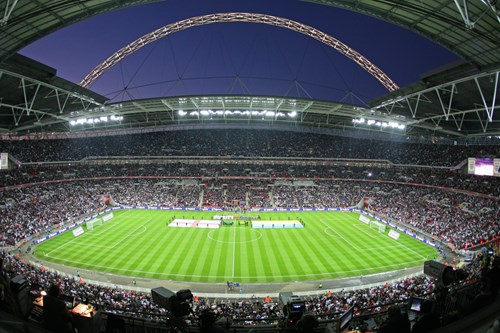
Often considered the ‘home of football’, Wembley is one of the most iconic venues in the world. Home to the England national team and The FA, the newest version of the ground – which opened in 2007 – has hosted many classic fixtures, including two Champions League finals and fixtures at the 2012 Olympics. It’s also set to host a number of games at the postponed Euro 2020 tournament this summer.
Peaking at a capacity of 90,000, it is the largest stadium in the UK and the second-largest in Europe. But it’s the history entrenched in Wembley that truly brings it to life, with the new stadium located on the same site as England’s only ever World Cup win in 1966. That triumph lives on today at the venue for players and fans alike.
But the stadium’s fame transcends football. Rugby union and NFL games also take place at the North London venue, as well as concerts from the likes of Beyoncé and Coldplay.
UCFB students also have the opportunity to study at the Wembley campus, with lectures and seminars taking place in, and looking out over, the most famous pitch in the world. Find out more.
Old Trafford
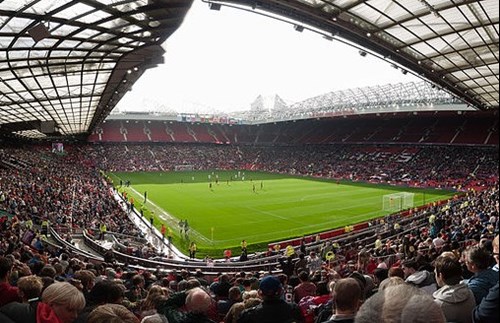
As one of the classic stadiums designed by the Archibald Leitch, Britain’s most famous football architect, Old Trafford’s towering presence reigns over the city of Manchester with a capacity of over 74,000. Its size is equalled in its success, as the ground has witnessed a staggering 20 top flight titles for Manchester United, more than any other stadium in the country.
Home to the all-conquering giants of English football since 1910, the stadium was described as the ‘Theatre of Dreams’ by Sir Bobby Charlton, a legend of the game for both United and England. One of its main stands is named after the World-Cup winning hero, and another pays tribute to the legendary Sir Alex Ferguson.
But the stadium serves as a token of history beyond the game, following heavy damage caused by bombs in the Second World War. This resulted in United sharing Maine Road, Manchester City’s former stadium, with their local rivals between 1941 and 1949. In the 1947/48 season, the Reds smashed the record for the most attended game in football league history, 83,260, which remains to this day. Despite owning the largest club stadium in England, United’s most watched game was played at the home of their fiercest rivals!
Craven Cottage
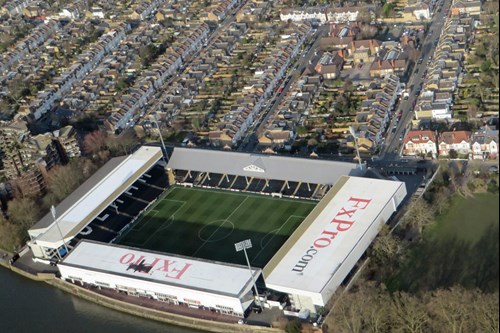
Not all of the best stadiums belong to the most dominant sides in English Football. Craven Cottage, home to Fulham since 1896, has a modest capacity of 19,359, and this is precisely what gives the stadium a unique charm and intimate atmosphere. With fans in touching distance from the edge of the pitch, the ground transports them to a football experience that primarily belongs in the past.
The stadium acquired its name from an 18th century cottage that served as a royal hunting lodge for the monied elite. After being destroyed in a fire and left abandoned, the land was so overgrown when Fulham discovered it that it took two years to transform it into a football pitch.
Having had eight previous grounds, the second most in English football, Fulham settled at Craven Cottage in 1896, making it the oldest stadium in London. The club have battled tirelessly to overcome attempts to close the ground, and in being successful have retained a truly historic and authentic venue that showcases football at its very best. A new riverside stand is currently being built which will add a contemporary edge to one of English football’s most romantic venues.
Tottenham Hotspur Stadium
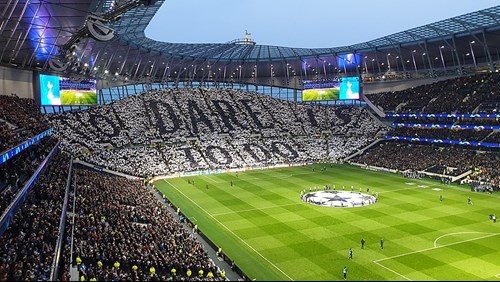
This new North London landmark may have only opened in 2019, but it’s already announced itself to the world as a picture of modernity and technological prowess.
The stadium is the world’s first to feature a dividing and removable football pitch, which covers a synthetic turf field that can be accessed for American football games, as part of the NFL London series, and concerts amongst other events. It also features a glass walkway on the roof, from which you can abseil down, stadium-wide Wi-Fi access, a museum and even a brewery.
Despite its impressive array of attractions, the stadium’s main focus was to maintain the electric and intimate atmosphere of White Hart Lane. Designed in a similar fashion to concert halls with good acoustics, the corners of the stadium are enclosed to trap the sound within the stadium and allow it to roar thunderously around the pitch. None more so than from the 17,500 capacity south stand – the biggest single-tiered stand in the UK.
Etihad Stadium
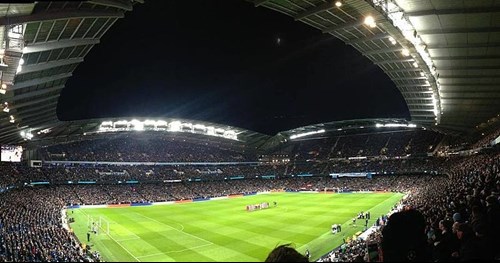
The Etihad Stadium, also known as the City of Manchester stadium, initially opened as an athletics arena for the 2002 Commonwealth Games before being transformed into a Premier League football stadium.
Its award-winning architecture was designed to be “an intimate, even intimidating, gladiatorial arena embodying the atmosphere of a football club”, with the pitch six metres below ground level to replicate Roman amphitheatres. Its spectacular visuals and site lines ensures a terrifying trip for any opposition side visiting the stadium.
The ground is renowned for hosting events beyond football, including the 2015 Rugby World Cup, a boxing world title fight and music concerts in football’s off-season, replacing Maine Road as a cultural landmark in Manchester.
UCFB students can choose to study at the Etihad Campus to kickstart a career in the football and sports industry with state-of-the-art learning facilities. Find out more.
Celtic Park
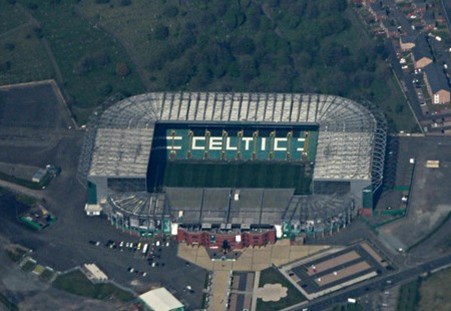
Initially built as a driving force against poverty in Glasgow, Celtic Park has gone on to become a cornerstone of the club and city that surrounds it. Having remained at the same site since 1892, the stadium serves as a cultural landmark and has hosted religious ceremonies, war recruitment events and the 2014 Commonwealth Games.
It may be Scotland’s biggest football stadium, but Celtic Park has a distinct Irish flavour to it. The football club was established by an Irishman and its name was chosen to reflect Celtic’s combined Irish and Scottish identity, while the likes of Martin O’Neill and Roy Keane, amongst others, have helped reinforce these links.
One of the stadium’s stands is named after former manager Jock Stein, who famously said “football without fans is nothing”. The last year may have tested and trialed this quote in a way we could never have anticipated, but the dependency on fans to inject life into the game rings true nowhere more than Celtic Park. Renowned for its sensational atmosphere and animated crowds, the stadium embodies old-fashioned football at its finest, particularly when Rangers and their fans visit.
Anfield
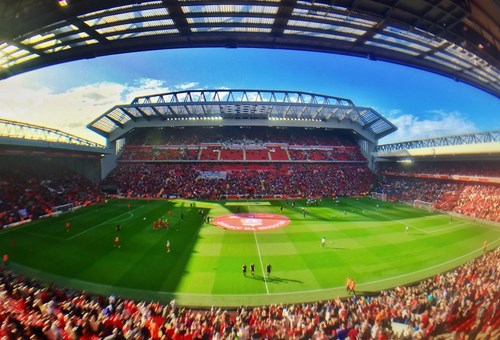
The home of Liverpool FC since their formation in 1892, Anfield has retained a sense of culture and belonging despite recent developments to give it a capacity of 53,000.
Initially home to local rivals Everton from 1884-1892, the stadium has now become synonymous with Liverpool – both as a football club and city. Renowned for its distinct character, with choruses of ‘You’ll Never Walk Alone’ ringing round the stadium and beyond, fans at Anfield don’t simply generate an atmosphere, but a community.
With history steeped in every corner of the stadium, there is a stand named after famed player and manager Sir Kenny Dalgleish, and two of the entrance gates are named after club legends Bill Shankly and Bob Paisley. Shankly also installed the iconic ‘This is Anfield’ sign that the players must pass before entering the pitch, to instil fear into the opposition.
Rival manager Pep Guardiola has commented previously: “The motto ‘This is Anfield’ is no marketing spin. There’s something about it that you will find in no other stadium in the world.” Shankly’s plan seems to have worked.
The Principality Stadium
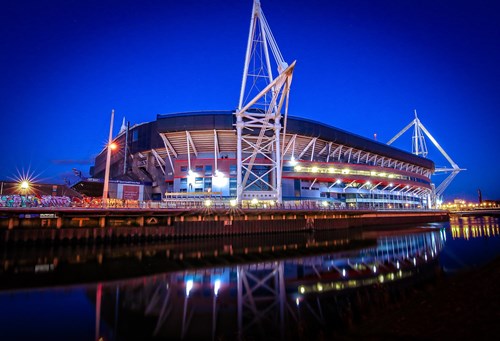
The Principality Stadium, more commonly known as the Millennium Stadium, is the home of Welsh sport. Built for the 1999 Rugby World Cup, the first game played at the stadium saw Wales defy the odds to beat South Africa 29-19, which many took as an emphatic sign.
As an iconic Welsh landmark in Wales, the Cardiff-based stadium has also hosted international football games, the Speedway Grand Prix and even the Tsunami Relief Cardiff concert. With a capacity of over 74,000, the ground stepped up for the FA Cup and League Cup finals between 2001 and 2006 when Wembley was being redeveloped.
With a fully retractable roof and a black curtain, or drape, that can reduce the capacity down to 12,000, the multi-purpose stadium features a range of innovative designs. But not everything about the stadium is quite so advanced. They employ a resident hawk named Dad, who is in charge of driving away seagulls and pigeons from the stadium on match days.
The Racecourse Ground
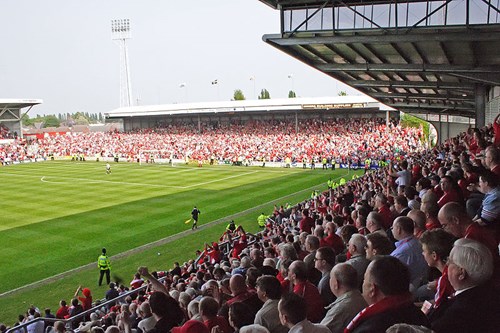
Founded in 1864 to provide cricketers with entertainment during the winter, the Racecourse Ground is home to Wrexham AFC, the third-oldest professional football club in the world.
Having hosted the first Welsh football match in 1877, the Racecourse has held more international matches for its country than any other stadium and is the oldest ground in use in which global fixtures are played.
With a capacity of only 10,500, and formerly used for horse racing, the stadium’s rich history is heightened by the ground’s intimacy, seen most clearly in the all-standing Kop. The stand was once the largest terrace in the English Football League and still remains intact today.
While National League side Wrexham have struggled in recent years, they were recently bought by Hollywood stars Ryan Reynolds and Rob McElhenney. The pair have great ambitions for the club, and announced that when the Racecourse re-opens to fans, they will be the first to step foot through the door.

















